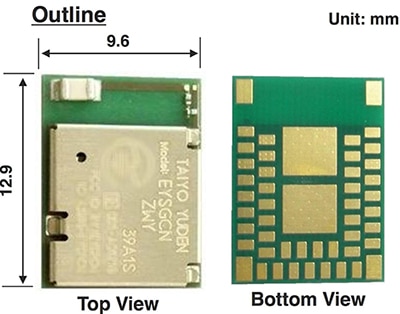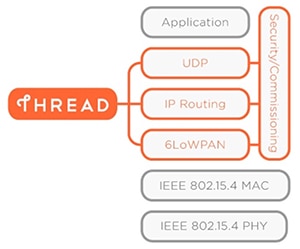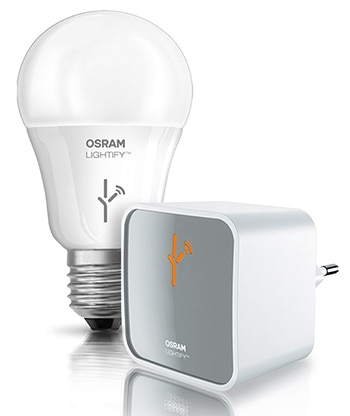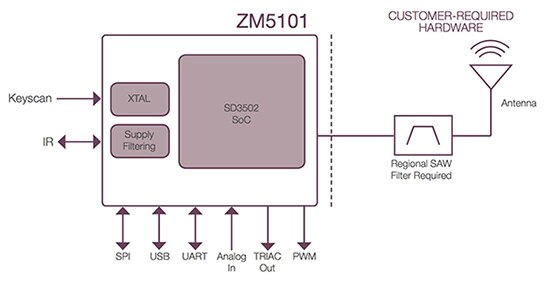Choosing a Wireless Technology for a Smart Lighting Project
投稿人:电子产品
2016-05-05
ZigBee® wireless technology with its ZigBee Light Link (ZLL) profile (which includes support for mesh networking, fundamental for smart-home applications) has proved itself a strong candidate for smart-lighting applications. However, ZigBee doesn’t have the market all to itself. The smart-lighting sector is set to boom and that’s attracted other wireless technology vendors to the fray. Each claims its own advantages.
This article builds on earlier TechZone smart lighting articles by comparing the strengths and weaknesses of competitive wireless technologies with ZigBee. The article leads on to outline the chips and modules available from Silicon vendors keen to persuade lighting designers to incorporate their wireless technology into the next smart light product.
Technology fusion
There have been many attempts to endow lighting with a degree of "intelligence." Much of the early effort was targeted at energy saving and was based on using the existing power cables as a data corridor. Lighting was also wired up to sensors that detected daylight and/or movement. Such systems were proprietary, expensive, and difficult to install. Today, however, smart lighting is a key element of home automation. Contemporary systems differ from the clunky products of yesteryear by fusing two young technologies––Solid State Lighting (SSL) and wireless connectivity. SSL enables a wide range of luminosity, color, and temperature which infuses each room (or even different parts of the same room) with a different ambience, while wireless connectivity makes it easy for the consumer to select that ambience from a remote control device (often a smartphone) either while at home or located remotely (Figure 1).

Figure 1: The smartphone is a popular interface for controlling smart lighting. (Courtesy of ilumi)
While simple in concept, designing wirelessly enabled lighting is anything but, and a lighting engineer could be forgiven for shying away from integrating RF capability into his or her next SSL design. However, such an approach could result in a missed opportunity. The good news is that embracing wireless connectivity no longer demands a high level of RF expertise because semiconductor vendors now offer reference designs, development tools, and integrated solutions, third-party manufacturers can supply "drop-in" modules that demand little or no compliance testing, and distributors promote in-house design services to help customers get started. Nonetheless, the process is not trivial and the challenge starts with selecting the correct wireless technology.
The main choices––based on technology maturity and market acceptance––for smart-lighting applications are Bluetooth Smart® technologies based on an IEEE802.15.4 physical layer but using different protocols (for example, Thread), Wi-Fi®, ZigBee, and Z-Wave®.
Bluetooth Smart vs. IEEE 802.15.4
Bluetooth Smart is the low-energy version of Bluetooth wireless (many engineers still refer to the technology as "Bluetooth low-energy") that was introduced as part of the Bluetooth Core Specification v4.0 in 2010. It was specifically designed for low-power (battery) operation but still offers a healthy 1 Mbps (raw data) bandwidth and a range of tens of meters. Like several other popular wireless technologies, Bluetooth Smart operates in the 2.4 GHz (Industrial, Scientific, Medical [ISM]) spectrum allocation primarily because the band is license-free (although there are rules defining transmission power and other aspects of operation).
Bluetooth Smart differs from "classic" Bluetooth in its technical details (for example, unlike classic Bluetooth technology, Bluetooth Smart can normally be in a "not connected" state (saving power) where the two ends of a link are aware of each other, but only link up when necessary and then for as short a time as possible. Once connected, Bluetooth Smart switches to one of its 37 data channels (compared to 79 for classic Bluetooth) and during the short-data transmission period the radio flips between channels in a pseudo-random pattern using Adaptive Frequency Hopping [AFH]. The frequency hopping technique is a popular mechanism for avoiding interference from other devices using the 2.4 GHz ISM band.
As a derivative of classic Bluetooth, Bluetooth Smart betrays its consumer roots. That brings some advantages to smart-home applications and a few drawbacks. The key advantages are consumer familiarity, a widely established ecosystem, and a multivendor supply chain. The established ecosystem includes adoption in mobile devices such as smartphones and tablets, enabling smart-lighting control apps to interoperate with smart lights without an intermediary device such as a hub or gateway – simplifying installation and lowering costs. The downside is that Bluetooth wireless was designed as a personal area networking (PAN) technology, with a central master controlling multiple slaves in a star topology. Smart lighting works best when interconnected using mesh networking such that individual nodes (the lights) can communicate with each other in addition to a controller to extend range and enable additional functionality, for instance to synchronize the operation of groups of lights.
Some Bluetooth Smart chip suppliers, notably CSR with its CSRmesh™ Platform, have introduced mesh-networking solutions to overcome the technology’s lack of support for this topology. The Bluetooth Special Interest Group (SIG), custodians of Bluetooth technology, has announced mesh support (together with range and bandwidth enhancements) will be included in the next update of the standard due sometime in 2016.
Bluetooth Smart also includes support for IPv6––the latest version of the Internet Protocol––connectivity (although it is up to the chip maker to engineer a working solution and few have done so thus far) which would allow smart lights to connect directly to all other devices connected to the Internet (and a future Internet of Things [IoT]) without requiring the resources of a gateway such as a smartphone or Wi-Fi router. The advantages of such a connection might not be immediately obvious, but it would endow the system with a high degree of flexibility which could allow, for example, consumers to cede some control of their lighting to the electricity utility (so that some lights could be dimmed during periods of high demand) in return for a preferential tariff.
There are many Bluetooth Smart semiconductor vendors with CSR, Dialog Semiconductor, Nordic Semiconductor, and Texas Instruments (TI) among the leading suppliers. For engineers who don’t want the difficulties of designing a Bluetooth Smart-based circuit from scratch, there are also a number of module vendors. Modules typically come complete with compliance certification but take up more space and cost more than designs based on discrete components. Key module suppliers are Anaren, Laird, CEL, and Taiyo Yuden (Figure 2).

Figure 2: Taiyo Yuden’s Bluetooth Smart module packs a pre-certified solution into a 12.9 by 9.6 mm package.
U.S.-based manufacturer ilumi is a good example of a company that has used Bluetooth Smart for the wireless connectivity in its lighting solutions. ilumi’s Smartbulb uses Bluetooth Smart wireless connectivity from Nordic Semiconductor.
In addition to ZigBee, competition for Bluetooth Smart comes from other IEEE 802.15.4-based technologies. IEEE 802.15.4 defines the physical layer (PHY) and media access control (MAC) for low-power wireless personal area networks. Competing technologies, for example, MiWi, WirelessHART, and ZigBee differ in how the MAC and PHY layers are complemented with higher layers to determine the full functionality of the technology.
One of the most recent IEEE 802.15.4-based wireless introductions, dubbed Thread, has been designed specifically for home automation applications. By employing IEEE 802.15.4, Thread inherits a 2.4 GHz radio with a 250 kbps (raw data) bandwidth and range of tens of meters. The technology supports a mesh network comprising up to 250 devices. A key difference between Thread and other IEEE 802.15.4 technologies such as ZigBee is the addition of an IPv6 over Low power Wireless Personal Area Network [6LoWPAN]) layer which endows the technology with IPv6 support, "future proofing" it for IoT connectivity — and next-generation home-automation applications, according to the claims of the Thread Group (Figure3). The group also claims that Thread is more secure than "some other wireless protocols."

Figure 3: Thread’s stack includes a 6LoWPAN layer on top of an IEEE 802.15.4 MAC and PHY.
The key advantages of Thread are its support from large organizations such as ARM, Freescale Semiconductor, Nest Labs, OSRAM, Qualcomm, Samsung Electronics, and Silicon Labs which are among the group’s 220 members. (Although using technology partly based on Google IP (through its acquisition of Nest Labs) might also cause some OEMs to shy away from Thread.) The downsides of the technology are relatively limited bandwidth––which might restrict the capability of systems in the future––lack of smartphone interoperability and, as yet, very limited commercial semiconductor solutions.
Mature alternatives
Wi-Fi perhaps has the biggest advantage of all competing home automation wireless technologies: it’s already in a large percentage of homes. The existing Wi-Fi router could just as easily be used to tie together a smart-lighting system as it does the home’s computing devices, TVs, and set-top boxes.
Wi-Fi is based on the IEEE 802.11 standard and operates (primarily) in the 2.4 and 5 GHz spectrum allocation. Many versions of the technology are available, but the popular IEEE 802.11n type, for example, offers 70-Mbps (raw data) bandwidth and a range of up to 70 meters indoors. The technology is IP-based and designed around a central hub (a wireless access point) communicating with peripheral devices in a "star" topology (forming a local area network [LAN]). Wi-Fi Direct allows peer-to-peer connectivity––which would allow mobile devices such as smartphones and tablets to control smart lights directly if required, although a more likely operational situation would be control from the smartphone via a hub––but does not support mesh networking.
The key advantages of Wi-Fi as a smart-lighting wireless connectivity system are its ubiquity (and hence consumer familiarity) and wide availability. Leading Wi-Fi chip suppliers include Microchip, STMicroelectronics, and TI. Module suppliers include GainSpan and Atmel. The technology also offers good bandwidth, which might not seem like an immediate advantage for smart-light applications, but does offer room for future development (for example, rapid over-the-air firmware upgrades to enhance the smart lighting’s capabilities).
A nice module example is Atmel’s SmartConnect devices (some of which also include Bluetooth v4.0 capability). The WINC1500 IoT module, for instance, is an IEEE 802.11b/g/n Wi-Fi product targeted at home automation applications, including smart lighting, which the company claims is pre-certified and can be used by designers to add wireless connectivity with requiring IP stack or RF experience.
The downsides of Wi-Fi for smart-lighting wireless connectivity are the lack of mesh networking support, increased complexity and cost compared to other low-power wireless solutions, and power consumption (bandwidth and range cost power). While it could be argued that power consumption is not an issue for mains-powered lighting (although greater power generates more heat in what’s already a demanding situation from a thermal management perspective) it does become an issue for other home automation application that will likely be battery powered (for example, window and door locks). Such a situation would demand the householder embrace at least two wireless technologies to fully equip their smart home.
LED maker and lighting company OSRAM has chosen Wi-Fi connectivity for its LIGHTIFY LED smart lighting. The bulbs can be screwed straight into a conventional light fixture with a smartphone app allowing the user to control color, temperature, and dimming. The smart bulb communicates through a gateway which is in turn connected to the home Wi-Fi router (Figure 4).

Figure 4: OSRAM LIGHTIFY is controlled via a gateway which connects to the home’s Wi-Fi router.
Z-Wave differs from the other low-power wireless products described here in that it’s a sub-1 GHz technology. Operational frequency varies with geographical regions (for example, Z-Wave operates on the 908.4 MHz band in the U.S. and 868.4 MHz in Europe). That does mean it avoids the crowded 2.4 GHz band although the technology is still subject to interference from devices such as cordless phones. The technology was introduced by a Danish company which was then acquired by Sigma Designs in 2008 and has largely been adopted for home automation applications such as lighting, thermostats, and door locks. Z-Wave offers mesh networking capability (up to 232 devices), 30-meter range and a (raw data) bandwidth of up 100 kbps. There is no support for IPv6.
Z-Wave does offer some advantages over competing technologies. Chief among these are the technology’s maturity and proven interoperability. There is an alliance of 325 companies that supports the standard and includes some major security, lighting, and home automation firms. According to the alliance there are more than 1,300 certified devices on the market and 35 million compatible units sold. The alliance also claims that Z-Wave is the only wireless technology that delivers applications-level interoperability and maintains backwards compatibility across all versions
On the downside is Z-Wave’s lack of interoperability with mobile devices, no IPv6 support, and modest bandwidth which could limit future adaptation. Sigma Designs’ business model is to license Z-Wave which can mean it is more expensive than competing technologies. Moreover, as the owner of Z-Wave, Sigma Designs has a virtual monopoly on the silicon (there is one other supplier, a small Japanese semiconductor company) which might limit its appeal to some OEMs.
That said, Sigma Designs does offer a wide range of Z-Wave chips and modules. The ZM5101, for example, combines a Z-Wave SD3502 SoC (with a built-in microcontroller and Z-Wave RF transceiver), crystal and passive RF components within an 8 x 8 mm package (Figure 5). The ZM5202 is a pre-certified module which integrates similar circuitry to the ZM5101 SoC.

Figure 5: Sigma Designs’ Z-Wave System-in-Package includes a number of I/Os for control and dimming of smart lighting.
Linear LLC (not to be confused with the chipmaker Linear Technology) is a U.S.-based company that manufactures a range of Z-Wave home automation products. It has recently released a Z-Wave controllable, fully-dimmable, LED screw-in bulb that the company claims will offer over 22 years of life and is remotely controllable via a compatible hub.
Future interoperability
The smart home market is due a big shakedown as there are many competing technologies in the market. At present silicon manufacturers are hedging their bets by supporting multiple wireless protocols (often on the same chip) and current smart-bulb makers are keeping a foot in several camps (OSRAM, for example, makes a ZigBee version of its LIGHTIFY smart bulb in addition to the Wi-Fi type).
That makes choosing a wireless technology for a smart-light project tough. Key selection criteria should include mesh networking capability, smartphone interoperability, reasonable range and bandwidth, wide industry support, and low-power consumption. There is no clear leader as most of the wireless technologies were not developed specifically for home-automation applications and hence have been adapted to fit with inevitable compromises. The few that purport to be specifically targeted at the smart home were developed some years ago and typically fail to take into account how consumers would embrace mobile technology.[1]
Today, one of the IEEE 802.15.4-based technologies would seem like a good choice (although requiring a gateway to ensure smartphone compatibility) but if Bluetooth Smart’s enhanced version (due in 2016) can deliver on its promised mesh networking, bandwidth, and range improvements, its smartphone interoperability might see it gain an edge.
In the long term, it could be worth ensuring the selected technology offers (or plans to offer) IPv6 support (for example, in the form of a 6LoWPAN layer) because this does promise a degree of interoperability between the different protocols (particularly the IEEE 802.15.4-based technologies) plus genuine IoT connectivity. IPv6 would appear to be the likeliest route to achieve a “global home automation standard.”
For more information about the parts discussed in this article, use the links provided to access product pages on the DigiKey website.
Further Reading:
- "Smart Home Communication Technologies and Applications: Wireless Protocol Assessment for Home Area Network Resources," Tiago D. P. Mendes et al, Energies, July 2015.
免责声明:各个作者和/或论坛参与者在本网站发表的观点、看法和意见不代表 DigiKey 的观点、看法和意见,也不代表 DigiKey 官方政策。









